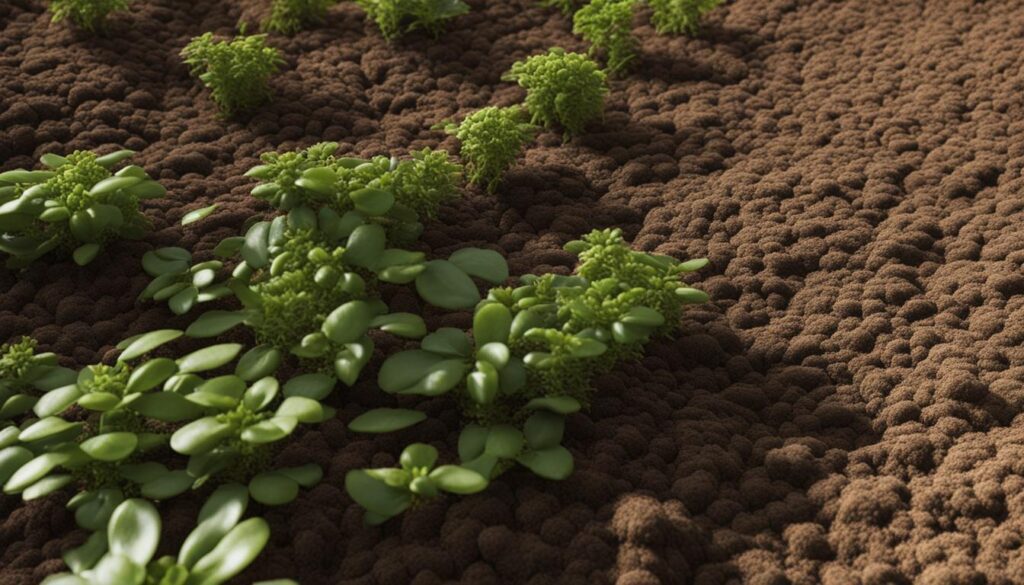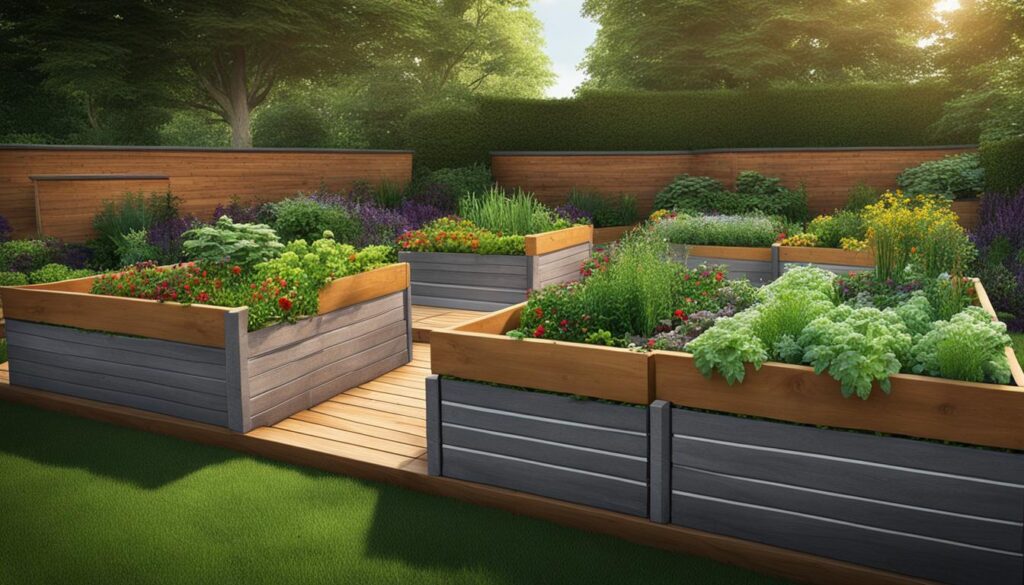Soil is the foundation for a successful garden. Healthy soil provides nutrients, structure, and moisture-holding capacity. Improving soil fertility is essential for thriving plants in xeriscape landscapes. By implementing sustainable gardening practices, you can boost your landscape’s resilience and create a thriving garden. Here are some master tips to improve xeriscape soil fertility.
Implement these expert tips to enhance the fertility of your xeriscape soil and create a vibrant and sustainable garden.
Key Takeaways:
- Adding organic matter enhances soil structure, water retention, and nutrient availability.
- Apply fertilizers based on soil test results for optimal nutrient supply.
- Consider the pros and cons of tilling in your garden based on climate, soil type, and pest presence.
- Adjust soil pH for plants with specific requirements, such as blueberries and azaleas.
- Raised beds can be a solution for challenging soils with poor drainage or heavy clay.
Importance of Organic Matter in Soil
Organic matter is a fundamental component of healthy soil. It plays a critical role in improving soil structure, water retention, and nutrient availability. By incorporating organic matter into your soil, you can create a fertile environment that supports vigorous plant growth.
Sources of organic matter include compost, animal manure, crop residues, and cover crops. These materials break down over time, releasing nutrients and forming stable aggregates that improve soil structure. Organic matter also enhances the soil’s ability to hold water, reducing the need for frequent irrigation.
“Organic matter is like a sponge in the soil, soaking up moisture and slowly releasing it to plants when needed,” says Dr. Jane Smith, a soil scientist at the University of X.
Furthermore, organic matter provides a source of food for beneficial soil organisms. These organisms break down organic matter into nutrients that are readily available to plants. This symbiotic relationship between plants, organic matter, and soil organisms creates a thriving ecosystem beneath the surface.
The Benefits of Organic Matter in Soil
- Improves soil structure
- Enhances water retention
- Promotes nutrient availability
- Supports a diverse and healthy soil ecosystem
By adding organic matter to your soil, you are not only improving its fertility but also contributing to sustainable gardening practices. It reduces the need for synthetic fertilizers and pesticides, promotes natural soil processes, and helps reduce environmental impact.
Table: Comparison of Different Sources of Organic Matter
| Organic Matter Source | Benefits | Considerations |
|---|---|---|
| Compost |
|
|
| Animal Manure |
|
|
| Crop Residues |
|
|
| Cover Crops |
|
|
Using Fertilizers to Enhance Soil Fertility
One of the key factors in improving xeriscape soil fertility is the proper application of fertilizers. Different plants have varying nutrient requirements, and soil compositions differ as well. By understanding the nutrient composition of your soil and the specific needs of your plants, you can provide the necessary nutrients for healthy growth.
When applying fertilizers, it’s important to consider the nutrient composition and availability in different soils. For example, grass growth in turf is more dependent on potassium than phosphorus. Utilizing fertilizers that contain the appropriate nutrients and following guidelines provided by reputable resources, such as OSU’s guide, can maximize soil fertility.
Before applying any fertilizers, it is recommended to conduct a soil test to determine the existing nutrient levels and pH of the soil. This will help you identify any deficiencies or imbalances that need to be addressed. By tailoring your fertilizer application to the specific needs of your soil and plants, you can ensure optimal nutrient uptake and promote healthy growth.
Table: Nutrient Composition and Application Recommendations
| Nutrient | Soil Requirement | Recommended Fertilizer | Application Rate | Timing |
|---|---|---|---|---|
| Nitrogen (N) | Promotes foliage growth | Nitrogen-rich fertilizers (e.g., ammonium nitrate, urea) | Varies based on crop and soil test results | Apply in early spring or when foliage growth is desired |
| Phosphorus (P) | Aids in root development and flower production | Phosphorus-rich fertilizers (e.g., superphosphate, bone meal) | Varies based on crop and soil test results | Apply at planting or during active growth |
| Potassium (K) | Enhances plant vigor and disease resistance | Potassium-rich fertilizers (e.g., potassium sulfate, potassium chloride) | Varies based on crop and soil test results | Apply before planting or during active growth |
Remember to apply fertilizers according to package instructions and avoid over-application, as excessive fertilizer use can lead to nutrient imbalances and environmental pollution. By understanding the nutrient composition of your soil and following recommended application rates, you can enhance soil fertility and promote the healthy growth of your xeriscape landscape.
Image source: https://seowriting.ai/32_6.png
The Till or No Till Debate
Tilling is a common practice in gardening and agriculture to prepare the soil for planting. However, the till or no till debate has been a topic of discussion among experts. Tilling involves turning over the soil, breaking it up, and incorporating organic matter. While tilling can help loosen compacted soil and control weeds, it can also lead to soil compaction, weed seed distribution, and soil erosion.
On the other hand, the no till approach advocates for minimal disturbance of the soil. Instead of tilling, this approach focuses on adding organic matter on top of the soil surface, such as mulch or compost, to improve soil fertility. The no till method helps retain moisture, enhance soil structure, and promote beneficial soil organisms. It also reduces soil erosion and minimizes weed germination.
The decision to till or not till depends on several factors, including climate, soil type, and the specific requirements of the crops or plants being grown. It is important to weigh the advantages and disadvantages of each approach and consider the long-term impacts on soil health and sustainability.
Table: Pros and Cons of Tilling and No Till
| Tilling | No Till |
|---|---|
| Loosens compacted soil | Retains soil structure |
| Controls weeds | Reduces weed germination |
| Promotes soil erosion | Minimizes soil erosion |
| Improves nutrient availability | Enhances soil microbial activity |
“The till or no till debate is an ongoing discussion in the field of agriculture and gardening. It highlights the importance of finding a balance between soil preparation and sustainable soil management practices.” – Expert Gardener
Ultimately, the decision to till or not till should be based on the specific needs and conditions of your garden or field. Consulting with local experts, conducting soil tests, and observing the long-term effects on soil health can help you make an informed choice. Remember, adopting sustainable soil management practices is crucial for preserving soil fertility and ensuring the long-term success of your garden or farm.
Adjusting Soil pH for Optimal Growth
Soil pH plays a crucial role in determining the availability of nutrients to plants. Some plants thrive in acidic soil, while others prefer a more alkaline environment. Adjusting soil pH can be done using specific amendments to create the ideal conditions for optimal plant growth.
For plants that require acidic soil, such as blueberries, azaleas, and rhododendrons, the pH needs to be lowered. This can be achieved by adding sulfur to the soil. Sulfur gradually lowers soil pH over time, allowing these acid-loving plants to thrive. It’s important to note that significant changes in soil pH may require substantial amounts of sulfur and may take time to take effect.
On the other hand, if the soil’s pH is too acidic and needs to be increased, lime can be added. Lime raises the pH of the soil, creating a more alkaline environment. However, it’s essential to carefully monitor the amount of lime added to avoid overcorrection, as excessive alkalinity can also be detrimental to plant growth.
Adjusting soil pH is an important step in creating the optimal conditions for your plants to thrive. By carefully monitoring and adjusting the pH level, you can ensure that your plants have access to the nutrients they need for healthy growth and development.
Raised Beds as a Solution for Challenging Soils
Dealing with challenging soils in your garden can be a frustrating experience. Clay soils that retain too much water, thin soils that lack nutrients, or poorly draining soils can all pose obstacles to successful gardening. However, there is a solution that can help overcome these challenges – raised beds.
Raised beds offer several advantages for improving soil conditions and promoting plant growth. One of the key benefits is that they allow for better control over soil quality. By filling the raised bed with a mixture of compost, topsoil, and other organic materials, you can create an ideal environment for plants to thrive.
Another advantage of raised beds is improved soil drainage. The elevated structure of the bed allows excess water to drain away more easily, preventing waterlogged soil conditions that can suffocate plant roots. This is especially beneficial for clay soils that tend to hold onto water.
| Advantages of Raised Beds for Challenging Soils |
|---|
| Improved soil quality control |
| Better drainage for clay soils |
| Increased soil depth for thin soils |
Raised beds also provide a solution for thin soils by increasing the available soil depth. This allows plants with deeper root systems to access more nutrients and water. Additionally, the increased soil depth provides a buffer against rapid fluctuations in temperature, helping to create a more stable environment for plant growth.
When constructing raised beds, it’s important to choose the right location and size for optimal results. Select a sunny area that receives at least six to eight hours of sunlight per day. Consider the specific needs of the plants you intend to grow and ensure the raised beds are large enough to accommodate their root systems.
In conclusion, raised beds offer a practical and effective solution for improving challenging soils in your garden. By providing better control over soil quality, improved drainage, and increased soil depth, raised beds can help create an ideal environment for plants to thrive. Consider incorporating raised beds into your gardening practice to overcome the limitations of clay soils, thin soils, or poor drainage and enjoy a flourishing garden.
Gardening Best Practices for Soil Improvement
When it comes to improving the soil in your garden, following best practices is key. Soil testing, plant grouping, and proper soil drainage are all essential factors to consider. By implementing these practices, you can create an optimal environment for your plants to thrive.
Soil Testing
Before making any amendments to your soil, it’s important to conduct a soil test. This will provide valuable insights into the nutrient levels and pH balance of your soil. Soil testing kits are readily available at garden centers or through online retailers. By knowing the specific needs of your soil, you can make targeted improvements and ensure that your plants receive the necessary nutrients.
Plant Grouping
Grouping plants with similar requirements is another effective practice for soil improvement. Different plants have varying nutrient needs, watering preferences, and sun exposure requirements. By grouping plants with similar needs together, you can provide them with the optimal conditions for growth. This makes it easier to provide the right amount of water, fertilizer, and other care requirements for each group of plants.
Proper Soil Drainage
Good soil drainage is crucial for healthy plant growth. When soil becomes waterlogged, it can lead to root rot and other issues. To improve soil drainage, consider adding organic matter such as compost or well-rotted manure to the soil. These organic materials help improve the soil structure and enhance its ability to drain excess water. Additionally, raised beds can be a useful solution for areas with poor soil drainage.
Table: Essential Gardening Best Practices for Soil Improvement
| Best Practice | Description |
|---|---|
| Soil Testing | Conduct a soil test to determine the nutrient levels and pH of your soil. |
| Plant Grouping | Group plants with similar requirements together for efficient care and nutrient management. |
| Proper Soil Drainage | Ensure good soil drainage by adding organic matter and considering raised beds. |
By implementing these gardening best practices, you can improve the fertility and health of your soil. This will ultimately lead to stronger, more vibrant plants in your garden. Remember to regularly test your soil, group plants based on their needs, and provide proper drainage for optimal results.
Soil Improvement Techniques for Trees and Shrubs
When it comes to planting trees and shrubs in your garden, it’s important to consider the existing soil conditions. Choosing the right plant species that thrive in your soil can significantly improve their growth and overall health. Additionally, implementing certain soil improvement techniques can further enhance their performance. Here are some tips to help you improve the soil for trees and shrubs:
- Plant selection: Before adding trees and shrubs to your landscape, research and choose species that are well-suited to your soil type. Different plants have varying soil preferences, and selecting the right ones can promote better growth and reduce the need for additional soil amendments.
- Mulching: Applying a layer of organic mulch around the base of trees and shrubs helps retain moisture, regulate soil temperature, and suppress weed growth. Mulching also gradually breaks down and improves the soil structure, providing essential nutrients to the plants.
- Proper planting technique: When planting trees and shrubs, dig a hole that is wide enough to accommodate the root ball without disturbing the surrounding soil too much. This allows the roots to establish themselves more easily and improves their access to nutrients in the soil.
“Choosing the right plant species that thrive in your soil can significantly improve their growth and overall health.”
Improving the soil for trees and shrubs requires a combination of plant selection, mulching, and proper planting techniques. By paying attention to these factors, you can create a favorable environment for their growth and ensure their long-term health in your garden.
| Plant | Soil Preference |
|---|---|
| Oak | Well-drained, loamy soil |
| Azalea | Acidic, well-drained soil |
| Juniper | Sandy, well-drained soil |
Additional Resources:
- Improving Soil for Planting Trees and Shrubs – Detailed guide by Oregon State University Extension on soil improvement techniques for trees and shrubs.
- Mulching Trees and Shrubs – University of Arkansas Cooperative Extension Service publication providing information on the benefits and techniques of mulching.
Turf Soil Improvement Tips for a Lush and Healthy Lawn
Your lawn is the centerpiece of your landscape, providing a beautiful and inviting space for outdoor activities and relaxation. To ensure a lush and healthy lawn, it is essential to focus on improving the soil quality. By implementing some key soil improvement tips, you can create an environment that promotes strong root growth, efficient nutrient uptake, and overall turf health.
Soil Testing for Precise Nutrient Management
Before embarking on any soil improvement efforts, it is crucial to conduct a soil test to assess its nutrient levels. Soil testing provides valuable insights into the pH levels, nutrient deficiencies or excesses, and overall soil composition. Based on the test results, you can develop a precise nutrient management plan that addresses specific deficiencies and promotes optimal turf growth. A professional soil testing service or your local agricultural extension office can guide you through the process and provide recommendations tailored to your lawn’s needs.
Proper Fertilization for Balanced Nutrient Supply
Fertilization is a key aspect of turf soil improvement. Choosing the right type of fertilizer and applying it at the correct time and rate is essential for maintaining a balanced nutrient supply to your lawn. Nitrogen, phosphorus, and potassium are the primary nutrients required by turfgrass. However, different grass species and soil conditions may have varying nutrient requirements. Consult the soil test results and refer to fertilizer guidelines provided by your local extension office to ensure you are providing your lawn with the nutrients it needs for optimal growth.
Watering Practices for Deep Root Development
Proper watering practices play a crucial role in turf soil improvement. Deep and infrequent watering promotes deep root development, making your lawn more resilient to drought conditions. Watering your lawn deeply and less frequently encourages the roots to grow deeper into the soil, accessing essential nutrients and promoting overall turf health. Avoid shallow watering, which can lead to shallow root growth and make your lawn more susceptible to stress and damage.
Sustainable Lawn Care for Long-Term Soil Health
It is important to approach lawn care from a sustainable perspective to maintain long-term soil health. This includes practices such as leaving grass clippings on the lawn to provide organic matter and natural fertilization, practicing proper mowing techniques to prevent stress and scalping, and minimizing the use of pesticides and herbicides that can disrupt the delicate balance of the soil ecosystem. By adopting sustainable lawn care practices, you can create a healthy and vibrant lawn while minimizing the environmental impact.
| Soil Improvement Tips for Turf | Benefits |
|---|---|
| Conduct regular soil testing | – Precise nutrient management – Optimized fertilizer application |
| Fertilize according to soil test results | – Balanced nutrient supply – Enhanced turf growth |
| Water deeply and infrequently | – Deep root development – Improved drought tolerance |
| Adopt sustainable lawn care practices | – Long-term soil health – Reduced environmental impact |
Stormwater Management and Soil Health
“The management of stormwater is crucial for preserving soil health and preventing pollution.” – Environmental Scientist
Proper stormwater management is essential for safeguarding soil health and preventing pollution. When rainwater is not adequately managed, it can cause soil erosion, wash away valuable topsoil, and carry pollutants into our waterways. Effective stormwater management strategies help mitigate these issues and promote sustainable landscaping practices.
One key aspect of stormwater management is the prevention of soil erosion. Erosion can lead to the loss of fertile topsoil, which is vital for plant growth and overall soil health. Planting vegetation and implementing erosion control measures, such as retaining walls and terraces, can help minimize soil erosion and protect the integrity of the soil.
Additionally, pollution prevention is a critical component of stormwater management. As stormwater runoff flows over paved surfaces, it can accumulate pollutants, including fertilizers, pesticides, and motor oil, which can have detrimental effects on soil health. Installing stormwater management systems, such as rain gardens and permeable pavement, can help capture and filter runoff, reducing pollution and protecting the soil.
| Benefits of Effective Stormwater Management | Strategies for Soil Health Preservation |
|---|---|
|
|
By implementing effective stormwater management strategies, you can protect the health of your soil and contribute to a cleaner environment. Preserve the integrity of your soil by preventing erosion and reducing pollution, ensuring the long-term sustainability of your landscaping efforts.
Soil Improvement Strategies for Annuals, Perennials, Bulbs, and Groundcovers
If you’re looking to improve the soil in your flower beds, consider implementing these strategies for optimal growth and fertility. Testing your soil and understanding its drainage capacity will help you determine the best course of action. When selecting plants, choose those that are well-suited to your soil conditions. Grouping plants with similar needs will ensure they receive the proper care and nutrients, leading to healthier growth.
Plant Selection
Choosing the right plants for your flower beds is essential for improving soil quality. Some species are more adaptable to different soil conditions, so it’s important to select those that can thrive in your existing soil. Consider factors such as pH levels, moisture requirements, and sun exposure when making your plant choices. By selecting plants that are well-suited to your soil, you can promote healthy growth and reduce the need for excessive soil amendments or fertilizers.
Mulching
Mulching is an effective technique for improving soil fertility in flower beds. By placing a layer of organic mulch around your plants, you can conserve moisture, suppress weed growth, and enrich the soil as the mulch breaks down over time. Organic mulches, such as wood chips or compost, also provide essential nutrients to the soil, promoting healthier plant growth. Make sure to maintain a layer of mulch that is 2-3 inches thick, keeping it away from the base of the plants to prevent rotting.
| Benefits of Mulching | Types of Mulch |
|---|---|
|
|
Using organic mulch in your flower beds not only helps conserve moisture and suppress weed growth but also improves the overall health and fertility of your soil. It’s a simple yet effective way to enhance the growing conditions for your plants.
By implementing these soil improvement strategies for annuals, perennials, bulbs, and groundcovers, you can create a thriving garden with healthier and more vibrant plants. Remember to test your soil, choose suitable plants, and use mulch to enhance the fertility and structure of your soil. With proper care and attention, your flower beds will flourish, providing a beautiful and sustainable landscape for years to come.
What are the Best Fertility Improvement Tips for Xeriscape Gardens?
When it comes to soil preparation for xeriscape gardens, the key is to focus on improving water retention and reducing erosion. Incorporating organic matter, such as compost, can help increase soil fertility while adding mulch can help retain moisture. Additionally, choosing drought-tolerant plants is essential for successful xeriscaping.
Conclusion
To improve soil fertility in your xeriscape garden and promote sustainable gardening practices, it is important to implement a combination of techniques. Adding organic matter such as compost, animal manure, and crop residues can enhance water retention, soil structure, and nutrient availability.
Applying appropriate fertilizers based on soil test results can provide the necessary nutrients for healthy plant growth. Understanding the nutrient composition and availability in different soils is crucial for effective fertilization.
Adjusting soil pH as needed and considering raised beds for challenging soils can further optimize your garden’s fertility. By following these tips and implementing best practices in gardening, you can create a resilient and thriving xeriscape garden while promoting sustainability.














